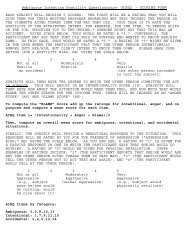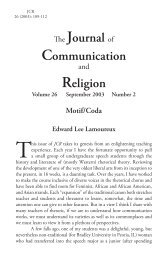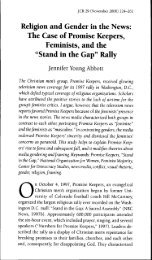"History, Analysis and Performance Considerations of Gerald Finzi's ...
"History, Analysis and Performance Considerations of Gerald Finzi's ...
"History, Analysis and Performance Considerations of Gerald Finzi's ...
You also want an ePaper? Increase the reach of your titles
YUMPU automatically turns print PDFs into web optimized ePapers that Google loves.
49agogic stresses to achieve a fitting text accentuation is strikingly apparent than in his setting <strong>of</strong>the lines <strong>of</strong> Crashaw’s, “Lo, the Bread <strong>of</strong> Life” stanza. Such statements as “This day’sTriumphant Text,” <strong>and</strong> “To the great twelve distributed,” highlight Finzi’s ability to find theaural <strong>and</strong> notational gesture most fitting the spirit <strong>and</strong> rhythm <strong>of</strong> a text, while (contrary to itsawkward appearance in the score) maintaining a most effective <strong>and</strong> natural musicality.As Section D draws to a close, its own dynamic arch rapidly descending at measure 123,the music takes an unanticipated turn. Here Finzi sets one last gasp, a short <strong>and</strong> final rise on“When Life, himself, at point to,” reaching a musical peak at Crashaw’s poetically moving “die<strong>of</strong> love.” The soprano D♯ against the organ pedal E, heightened by emotive downward <strong>and</strong>upward leaps <strong>of</strong> resolution, 59 paint a bittersweet glow around the image <strong>of</strong> the Last Supper.Theme j having transitioned through the common tone relationships <strong>of</strong> G major, E major, <strong>and</strong> G♯minor (in a dominant capacity), comes finally to harmonic rest in C♯ major on the word“Legacy” (measure 125). Plagally-prepared <strong>and</strong> mode-shifted on the last note <strong>of</strong> the section, thiscadential formula, together with final organ intimations <strong>of</strong> “this sovereign subject,” follows thefavored Finzian figure (see Figures 22 <strong>and</strong> 32).A reduction <strong>of</strong> theme j indicates a subtle upward shift in the background line from G toG♯, balancing in small degree the earlier descent <strong>of</strong> themes h <strong>and</strong> i (see Figures 31 <strong>and</strong> 33). Tosummarize the thematic structure <strong>of</strong> Section D, following the psalm tone introduction, the twonew celebratory march themes delineate the anthem midpoint, providing both its climax <strong>and</strong> thebeginning <strong>of</strong> its long recapitulation (see Table 4).59 Double appoggiatura with octave transfer.








